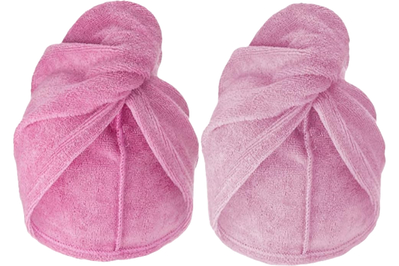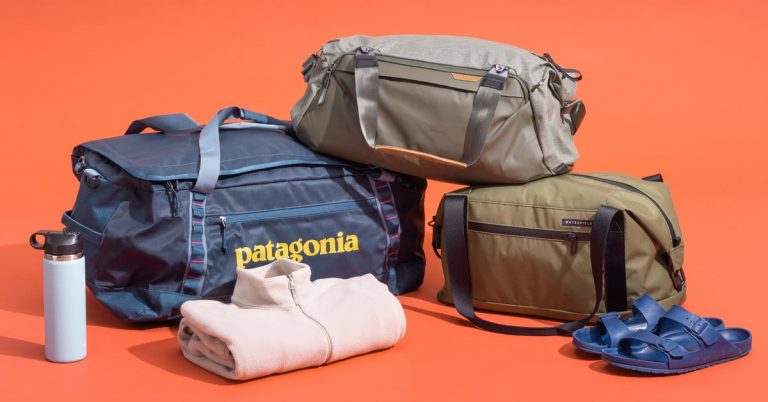I Thought the Turbie Twist Was a Waste of Money. Then I Had Surgery.
I was watching reruns at my grandma’s house when I saw a commercial for the Turbie Twist Microfiber Hair Towel for the first time.
It was sometime in the early 2000s, and as a self-conscious preteen just starting to care about my looks, I was immediately captivated by the lightweight, tapered towels and the beautiful women wrapping their hair with them.
By the end of the ad, I was convinced that this fitted hair towel was a necessity. When the “buy now” number flashed at the bottom of the screen, I sat up straight and called out to my mom. “I need one of those,” I announced with the kind of conviction only a bratty 12-year-old could muster. My mom, used to my antics, just rolled her eyes and said, “No, you don’t, we have towels at home.”
I sat with my mom’s words, turning them over in my head. She was right. We did have towels at home, and I’d been using them for as long as I could remember to dry my hair after a shower. I decided right then and there that a towel designed specifically for your hair was an unnecessary extravagance, even if this commercial tried to convince me otherwise.
For nearly 20 years, I held on staunchly to this belief. Why buy a towel I can only use for my hair when I could easily twist a body towel (that I already own!) into a hair-wringing turban?
Then, I had brain surgery, and suddenly the Turbie Twist became something I simply couldn’t live without.
If you’ve used a body towel to wrap up your hair after a shower, you’re probably familiar with the process: You have to bend at the waist and flip your head forward so that your damp hair hangs upside down. From there, you place the long edge of the towel at the nape of your neck and twist the fabric around your hair, straighten up, and secure the towel atop your head.
After I had brain surgery, flipping my head upside down was a no-go. For the first six weeks after my procedure, I was instructed to keep my head above my heart to reduce swelling and prevent dizzy spells. Without wringing out my locks, my long hair hung heavily down my back after I showered, clinging wetly to my skin.
Desperate for a way to keep my sopping wet hair off the back of my neck, I caved and ordered a Turbie Twist.
I haven’t looked back since.

The Turbie Twist has a unique, tapered shape that resembles a hood and is closed at both ends, which allows me to capture all of my hair without bending over. To use it, I position the wider end at the base of my neck. I tilt just my head forward so my wet hair hangs freely and gather it into the skinny end of the towel. I twist the towel (and my hair) until it feels snug, then bring the twisted end up and over my head, securing it by threading it through the elastic loop on the wider end of the towel.
As an extra precaution, while I still had staples in my head, I wore the Turbie Twist backwards. I didn’t want my hair hanging over my staples, afraid that it could potentially get twisted in the metal and irritate the surgery site. So, I positioned the wider end of the towel against my forehead rather than the base of my neck, and twisted the length of my wet hair into the skinny end. Then I brought it up over the back of my head, securing the end in the elastic loop.

The Turbie Twist is made of microfiber, a highly absorbent material that helps hair dry faster than a regular towel. In fact, microfibers are capable of “absorbing over seven times their weight in water and they dry in one-third of the time of ordinary fibers,” according to authors S.A. Hosseini Ravandi and Masoumeh Valizadeh in Improving Comfort in Clothing. Soft microfiber cloth is also more gentle on your hair, which reduces breakage and frizz and, more importantly, was crucial for my head’s post-surgery tenderness.
Even though I’ve fully recovered from my surgery, I still use my Turbie Twist after every shower — and now that my staples have been removed, I wear it the right way.
Before I tried the Turbie Twist, I was convinced that it was no different than the body towels I’d been using for years. After using it every day for six weeks, though, I’ve realized how delightful it is to dry your hair with a towel designed specifically for that purpose.
It’s thin and lightweight, which makes it more comfortable to wear, and, unlike the top-heavy turbans I used to twist out of my body towels, it stays in place until I’m ready to remove it. And I’ve noticed that my hair looks and feels a lot healthier too; it’s not as frizzy as it used to be, and it tangles a lot less now.
I’ve even bought a few more Turbie Twist towels to take with me when I travel. Because they dry so quickly, I never have to worry about packing a damp towel in my bag when my vacation comes to a close. I also like to keep one in my swim bag, often wearing it home from the pool after a workout.

The Turbie Twist has been around since the early aughts, and in the years since it first debuted, it’s inspired a handful of competitors.
Curious to see how other brands compared, I ordered a set of three Hicober hair towels, an affordable option with mostly positive reviews on Amazon. I wasn’t impressed when they arrived: Though they were the same shape and length as the Turbie Twist, the Hicober towels were made of a thicker material that took a lot longer to dry. I also found Hicober towels harder to secure; you have to loop the elastic around a button, which requires a lot of fiddling.
If you had asked me a year ago, I would have told you the Turbie Twist is an unnecessary waste of money. And unless you are having brain surgery, it really may not be a necessity. But, in my experience, it is better than using a regular towel as a turban to dry hair. So, do you really need a Turbie Twist? No. But is it one of my favorite little luxuries? Absolutely.
This article was edited by Hannah Rimm and Megan Beauchamp.







